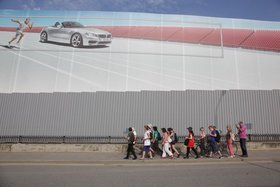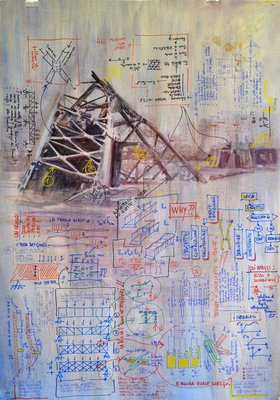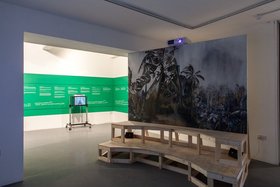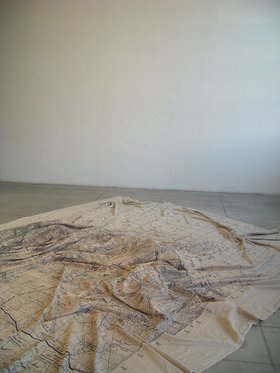Interviews
A Mobile Agent
Adelita Husni-Bey in conversation with Stephanie Bailey
In this interview, Libyan-Italian artist Adelita Husni-Bey talks about the idea of 'positionality' for an artist who comes from both sides of the regional divide. Being half-Libyan and half-Italian not only raises the issue of nationality when it comes to how artists are defined, but also reflects on the problems produced when thinking about identity in the twenty-first century, either in terms of the nation-state or in terms of a national or cultural identity. Considering the impact of globalisation, Husni-Bey talks about how she utilises and mediates the complexities of cultural origin in a global world currently (or constantly) in the process of defining and redefining itself.
Stephanie Bailey: Firstly, in thinking about the theme of Platform 005, 'globalising tactics', I wanted to ask how you position yourself in the world as an artist and whether this reflects in your work?
Adelita Husni-Bey: I will attempt to answer by generally unpacking, first of all, the question of 'positionality'. I feel positionality should be a key issue for any artist: it means effectively articulating from 'where' one speaks. If one does not attempt to know from where one speaks one renounces a certain social responsibility, of acknowledging that there is a discourse to be articulated with others. One effectively renounces practising consciously and attempting to attribute a use-value to one's work from its inception.
Navigating positionality, one may find that it has a twofold nature: firstly, how we articulate our particular practice across the field of cultural production, the 'material' element of our work (from questions of process and production to dissemination), where we can have an agency, albeit a limited one. Secondly, how do we acknowledge and speak to a pre-figured position which is inscribed upon us; our class, our access to mobility, our gender and ethnicity which already assigns our work a certain value and meaning. I think this second point is particularly important for artists from the MENA region as more often than not it is our last names, gender and provenance, which, problematically, attributes us a certain cultural capital a priori.This superficially attributed cultural capital, far from being an offering of a true cultural stake, may be seen as a foiled attempt at multiculturalism. In this field, still heavily dominated by western (white patriarchal) discourse, artists from the MENA region are tokenized. The 'Arab Spring' has suddenly reactivated interest in artist practices from the region.
Personally, the aim for my work (such as radio shows, archives, articles, installations) is to analyse established systems of advanced capitalist organisation. From this position, I can articulate a practice that is varied in form and fostered by the particular agency and conceptual mobility that an artist has. With this agency and mobility I have been able to move flexibly between fields and conduct funded research under the guise of the 'art project'. Framing work in this guise can come with its costs; it is a laden frame, legitimised through a closed network of relationships and affinities, which operate at the expense of a self-reflexive understanding of the field at large. The evolution of my practice and a more general maturing has occurred precisely through asking these questions and shifting my understanding of what the role of the artist could be, and why, if we will, should we still want to use these terms.
SB: What terms are you talking about and how are they problematic in your view?
AHB: I am speaking here the term 'art' and 'artist'; what does it mean to be an 'artist' today? To be making 'art'? is it important to define these terms or rather let the sprawl of different qualities and approaches emerge? Yet if we don't have any sense of what constitutes works that have a particular cultural currency and urgency in their context will the market be the only meter of value?
This is of course an exaggerated vision and I value debating and critiquing art practice. But it's worth asking who we are debating for, and constantly deconstructing what being an 'artist' and making 'art' means in order to produce with a degree of lucidity. For example, if we look at Rozghar Mahmood Mustafa's work, where she asked local women in Sulaymaniyah to put their living room furniture out onto the streets and inhabit these public spaces the way they would have at home. In a culture which denied them visibility and where your body needs to be different in private and public space, is it important to call this 'art'? Who is it important for? And if it were just an 'action' exposed in it's differing levels of complexity would that do it more justice? Is it a linguistic fallacy or is there more behind this issue?
In 2009, I rented a billboard space in Turin for 3 weeks. The billboard stood in a working class area called Lingotto, which is also home of the first large-scale FIAT factory, now used to host both the art fair and the book fair. So in some ways that space is symbolic of all phases of capitalist production; from Fordism to Post-Fordism and finally Cognitive Capitalism, whilst the make up of the area is still predominantly linked to the space's previous industrial function. The billboard read: 'What would we do if we didn't produce and consume?' In this purposefully ambiguous question what I intended was to spark discussion and make whoever took the time to read it aware of how we intend production and consumption in purely economic terms. It was an attempt at trying to think about why this had happened to the way we were 'wired'. The billboard held no information, nothing pointing out to it being an artwork, nothing pointing out to a producer, it wasn't 'branded' in any way. When adding that framework or 'art' and 'artist' may equate to 'branding' then it is very clear to me that we stand to lose than to gain from using those terms and their frameworks. Whilst this is not always the case I feel there is interesting, albeit unresolved food for thought here.
SB: The same could be said for cultural labelling. In this light, how does your cultural background feed into your work, if it does? How you discussed being able to move flexibly between fields might also have a lot to do with the fact that you are culturally 'mixed'?
AHB: 'Cultural backgrounds' necessarily, as discussed above, are present in what we do and how we operate. The question is: how do we direct, voice, (mis)use or suffocate this background and what does it inevitably makes of us? My ethnicity, arguably part of my 'cultural background', is for me a constant source of interest and unease, which oscillates between what I have experienced subjectively and psychologically in Libya and Italy and what it means to be Italian and Libyan, politically.
In The Green Mountain, a project produced for Viafarini, Italy, in 2010, I tried to address this particular uneasiness between the possible exploitation I would subject myself to through looking at this issue mnemonically and how to represent what I thought was a telling and urgent reading of Libya's historical past. I looked at a specific part east of Benghazi, the Jebel Al Akhdar (the Green Mountain), which I remembered visiting as a child. I remembered lucidly and vividly the height of the grass and the deep red-ochre clayish soil. Yet I decided to completely omit any autobiographical references and to work on an installation that recouped other people's fragmented narratives, namely professional figures: geographers, speleologists and local guerrilla fighters and servicemen, and their experience of that terrain. Through this mechanism (which only becomes apparent upon reading about the exhibition's format), what could be interpreted as a reading of a 'MENA artist' of 'her region' was problematised though a refusal of 'seeing' or 'remembering' through the 'artist's eye'. Instead, this was substituted with the eye of white, male professional figures who had been shipped to Libya, or men who had participated as 'freedom fighters' during the war, and their competing visions of that space.
SB: What is your experience of Libya?
AHB: My experience of Libya is mainly that of the expat: a female child who often passed as white, to some degree segregated and protected, problematically, from the country itself. I suppose my suspicion towards a superficial attribution of knowledge of the region which is sometimes posited to me may at times may be born out of this experience of apartheid, being driven from enclosure to enclosure where everything pertained either to whites or a selected group of Libyans who had studied abroad and/or come into wealth. So what do I know? At times I feel personally I can only deeply speak of this particular condition, and in The Green Mountain project the shifting of perspective from a personal mnemonic position to its very critique, questioned the position I felt I was expected to speak from. This is not necessarily a critique of work that deals with the personal or subjective, or wants to discount my particular experience, but rather a critique of a pre-figured position, which I feel is demanded in recent MENA-focused exhibitions. This 'expected position' should be analysed, deconstructed and re-appropriated in order to allow for the mosaic of varied experiences that are present to emerge.
SB: How do you see your work as fitting into the theme of globalisation and has this been a concern of yours from the outset? In other words, how do you feel you work has evolved, as the art world itself has evolved within the remit of 'the global'?
AHB: I feel I have a story to tell which speaks to this question: I was recently considering a proposal to take a theater play produced in London to another city. The original play was conceived in collaboration with ex members of a housing co-op knocked down to make way for the Olympics in 2012. The displacement of these 470 people remains to date almost unknown. The actors of the play were the members of the co-op themselves, who recount and reflect on this space which has been lost. As the city, which should newly host the play is not in the United Kingdom, the actors involved will necessarily speak a different language in order to engage the public and would thus not be the original actors. What would it mean to take this play and perform it in another city or to translate the play and have these notions spoken by different bodies? Things get interesting when you find out that this city is suffering from a similar fate, a mega project is threatening one of it's neighborhoods. Could one sacrifice the site specificity of this work, could it be translated across geographical and linguistic boundaries if the social scenario could be constructively informed by it?
In this sense this project in particular deals with the localized effects of the transnational and violent nature of globalization as epitomized by the mega-project, yet I am also interested in how the work's very circulation is potentially framed by it. In particular how a multiplicity of 'art worlds' negotiate common terms and a grammar, which legitimises works and their authors across continents and across cultures. As I stated before, yet from a different angle, this global connectivity homogenises differing approaches so that they produce a similar kind of cultural currency.
As an artist who practices within the institutional sphere you are both subjected to and complicit in the situation. Yet unfortunately 'globalisation' is more than a 'theme', as the story of the work above illustrates. It's a grim reality. As we function primarily as artists in the field of representation, all we can do is attempt to grasp, analyse and deconstruct the effects of globalisation through culture, whilst being both subsumed and complicit in its mechanisms. Nevertheless, I hope I don't 'fit into it'. Rather, I hope to offer an interpretation and a questioning of some of its destructive effects. Yet is 'reflection' enough? At times one also needs to sit in front of a bulldozer.
SB: On this note, I wanted to talk about the work we are posting as part of Ibraaz Projects for Platform 005, Alwan (2013). You have said that it addresses ideas of cultural capital 'attached' precariously to artists who have operated mostly abroad and are suddenly asked to unproblematically represent a 'nationality', which you have called a 'trite and self-legitimising multicultural discourse which does not problematise the question of the expat elite who have studied abroad and how their practice is in danger of embodying a type of cultural imperialism.'
In this light, the work responds to a certain categorisation of culture. But at the same time, this idea of nationality is breaking down. This idea of 'expat elites' goes hand in hand with generations of what have been called 'third culture kids' – those of mixed race or who were born into this expatriate, global class you describe. As an artist, how do you mediate this in relation to the formal concerns embedded in a work like Alwan?
AHB: The video is a docu-fiction, partly based in reality: there was indeed a proposal to produce a monument to the fallen in Benghazi and the monument was indeed never built. It depicts the journey towards the site of the monument, yet it is momentarily slowed down and interrupted by a close up of a bullet-ridden structure. The close-up is a testimony of war, a detail which is not immediately clear but which should point to the existence of 'spontaneous' monuments, of fissures, slashes, in the plain of vision which hint to a recent violent past. There are different levels to the work, one which I just described: the existence of temporary and mobile reminders of war, the 'unmonumental', the haphazard and its extension: the refusal to represent, to legitimise and produce a 'stand-in' for these multiple fissures, traumas and ultimately deaths. The refusal of the commission stems from recognising that if the function of the monument is to produce a space for collective mourning, then that space is already present and it cannot be instrumentalised, fossilised and essentialised by the production of a state-funded representation of hurt, which inevitably produces selective histories.
This touches upon various questions present in our dialogue as you point out. The manner in which I have tried to navigate what we have discussed stems from the very feeling of uneasiness an artist may feel in being complicit in the monument's production. This uneasiness may be more pronounced if, returning to our previous conversation, the artist feels called on to tell a collective story and becomes an instrument in carving it. The monument plays into the idea of the nation state, it does so even more vividly if the nation is nascent and living a phase of turbulence where these projects can become 'stop-gaps' in an otherwise un-orderly production of constituencies. What would it mean to bring attention and light to transitory monuments or to monuments that were not born to last?
Watch Alwan, here: http://www.ibraaz.org/projects/47.
Adelita Husni-Bey (b. 1985) has studied sociology and fine art and is currently a studio fellow of the Whitney Independent Study Program. Her practice interests include the 'Land Issue', collective memory (the production of), dissent and control, anarchist pedagogy and free-schools which she explores through writing and installations. Her practice involves an analysis of current prevailing systems of organization in advanced capitalist societies in areas such as labour, schooling and housing, and an attempt to produce alternative social imaginaries.









